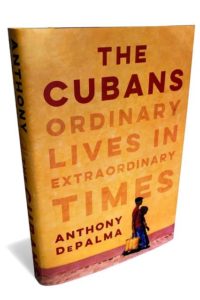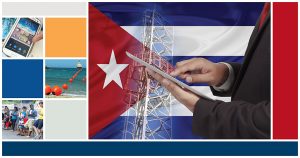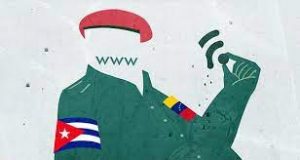The protesters pouring into streets across Cuba have a common rallying cry: “Patria y Vida,” or “Fatherland and Life.” The phrase comes from a hip-hop song released a few months ago by dissident Cuban artists who set out to challenge the government—and in the process helped spark a wave of protests against the 62-year-old communist regime, Santiago Perez and Jose de Cordoba write for the Wall Street Journal.
The San Isidro Movement inspired what was then the largest peaceful protest in Cuba’s six decades of communist rule—providing a catalyst for the current unrest, they add. It was set off by a government raid on performance artist Luis Manuel Otero’s dilapidated apartment, which doubles as the movement’s headquarters. The government’s response, promising to hold dialogues on free expression with protesters and then backtracking, fueled further discontent.
‘Movement began with a melody’
“How ruthless will the regime crack down? . . . They will be very ruthless,” Cuba analyst Brian Latell told the Wall Street Journal. A “notable” feature of the protests is “the lack of fear,” he added. “Cubans were marching in all those places, young and old, black and white.”
In a tweet, Cuba’s foreign minister suggested that U.S.-funded efforts to aid dissidents were behind Sunday’s protests. In recent weeks, Cuba has denounced the links between dissidents and the Mexico-based Cuba program director at the National Democratic Institute, the Post adds.
But political scientist Philip Brenner, a professor emeritus at American University, warned that “calling out for civilians to be some kind of police force is only going to create more problems.”
“They cannot just blame this on the Americans anymore,” he said. “The government needs to be smarter than this.”

WSJ
Cuban security forces have taken back the streets for now, but what happened over the weekend was extraordinary, notes Anthony DePalma, the author of “The Cubans: Ordinary Lives in Extraordinary Times.” Marchers shouting “We are not afraid” should frighten a government that has long kept its people terrified of even whispering their complaints, he writes for the Post.
“There are electricity blackouts which remind Cubans of the worst times of the 1990s after the collapse of the Soviet Union. And people are frustrated at the spread of COVID,” American University professor William LeoGrande told DW. The country is currently experiencing a record number of coronavirus cases.
In Cuba, people were complaining about the collapse of the economy, food and medicine shortages, price hikes and the government’s handling of Covid-19, the BBC reports. Sebastián Arcos, associate director of the Cuban Research Institute at Florida International University, told the Associated Press the protests were “absolutely and definitely fueled by increased access to internet and smartphones”.
Cuba’s 1989 moment?
“Telephones are now the guns of the Cuban people,” said Abraham Jiménez Enoa tells the Washington Post, a Cuban dissident journalist.
 “The internet was a facilitator in the protests because it allowed people to share pictures in real time on Facebook Live… These videos were made by protesters and not [opposition] personalities,” said Ted Henken, author of Cuba’s Digital Revolution.
“The internet was a facilitator in the protests because it allowed people to share pictures in real time on Facebook Live… These videos were made by protesters and not [opposition] personalities,” said Ted Henken, author of Cuba’s Digital Revolution.
“The problem they have now is that it’s not a handful of activists or artists or independent journalists — it’s now a massive swath of the population all throughout the country,” he said. “So the genie is out of the bottle. They’re trying to put it back in.”
It is too early to characterize this weekend as Cuba’s 1989 moment, says analyst James Bloodworth. But Cuba’s communist rulers are rapidly approaching a similar juncture to the one leaders of their Eastern European sister parties faced three decades ago. The Cuban Communist Party can liberalize the system and risk their own displacement, or it can deploy the full force of the state against the population, albeit right on the doorstep of the United States, he writes for Foreign Policy.
The Cuban government practices heavy handed censorship, but the parallel world of digital media helps ordinary Cubans stay informed, analyst Anne Nelson wrote in “Cuba’s Parallel Worlds: Digital Media Crosses the Divide,” a report for the NED’s Center for International Media Assistance.
 The movement began with a melody, Patria y Vida—Homeland and Life (above), the title of a collaborative song released this February by a group of Cuban hip-hop and reggaeton artists—a song that speaks volumes and has evolved into a rallying cry for change, NatGeo reports:
The movement began with a melody, Patria y Vida—Homeland and Life (above), the title of a collaborative song released this February by a group of Cuban hip-hop and reggaeton artists—a song that speaks volumes and has evolved into a rallying cry for change, NatGeo reports:
“Patria y Vida,” Cubans chanted in videos that went viral and served as a bullhorn for more to join as the day progressed. …Yotuel Romero, a singer with the Orishas band and one of the leaders of the Patria y Vida project, told the Miami Herald that the song is part of an “awakening of Cuban youth.” The song also has raised the profile of Afro Cubans. All of the singers are Black.
Arturo Lopez-Levy, a Cuba expert at Holy Names University in California, sees a “watershed moment,” the Post adds.
“This is the first time in 62 years that we see protests that are not localized,” he said. “I think it’s still within the universe of something they can control and survive. But if they do not act fast to address the economic and pandemic challenges, this situation could threaten their power.”
“Maybe not today. But if they can’t control this, where will the government be in three or four months?”
Sucediendo AHORA:
“ NO TENEMOS MIEDO” gritan los cubanos de San Antonio de los Baños protestando en las calles. #CUBACastro, @DiazCanelB, no se atrevan a reprimir! El mundo entero está mirando!#PatriaYVida pic.twitter.com/Zy2CMjuoGM
— Rosa María Payá A. (@RosaMariaPaya) July 11, 2021








